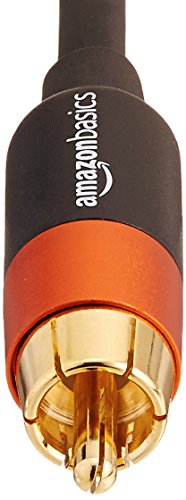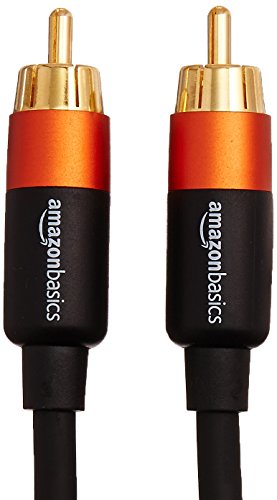- High-purity coaxial cable connects RCA-compatible digital audio components; can also be used with S/Pdif, digital, and composite video interfaces
- Ideal for compatible HDTVs, DVRs, cable/satellite boxes, Blu-Ray/DVD players, game consoles, subwoofer speakers, and more
- Corrosion-resistant gold-plated RCA connectors and split-tip center pins for enhanced contact pressure and conductivity
- Minimal energy loss and protection against RF/EM interference; easy-grip, color-coded molds; durable, yet flexible PVC exterior; cable measures 4 feet; backed by an AmazonBasics 1-year limited warranty
-
Information
-
Twitter
-
Pinterest
-
Youtube
-
Facebook




Leathaj Cooper Degraw
About as good as it gets at any price
The sound quality rating is kind of redundant. This is a digital transfer, 0s & 1s. You either get signal or you don’t, no variation in sound quality. It’s really only analogue cables that sound quality can vary. This inexpensive cable will sound exactly as good as any digital coax at any price. What does matter however is build quality and this is excellent. This ensures a snug fit and will last and has great protection against interference but that’s usually not an issue for short runs anyways. This cable is high quality all the way around for those of you still duped into thinking super expensive digital cables(digital-coax, optic, HDMI, etc) offer better sound than cheapies(they don’t). This Amazon Basics has all the materials and protection those high priced ones do and better than most quite frankly. That would be important for very long runs or if you have an outrageous amount of electronics going on or have it near a microwave or something. Either way your good here. This is highly durable, good looking cable, period. Why pay more?
Artika Lata
Don't Let the word "Basics" fool you.
Nothing Basic about these cables - They are solid, they are noiseless with absolute zero signal loss - which is critical in a Recording Studio - You need a Neutral Signal as you are not listening to your stereo here, but a live Band Recording so it's important that the Cables not add any Artificial Signal. These do not - Pure, Clear, and Durable.
Eddie De Leon
I don't think you can beat this for the value
I run about 6 of these in my HiFi system and they are really solid cables. The physical build quality is excellent, connections are tight, and sound quality is great. The world of cables is full of pseudo-science and promises of drastically improved A/V quality if you spend $80. Realistically, just buy these for $5 and you'll have the same experience.
Balint László Eduárd
Good quality cable
Good quality cable...does a fantastic job and has not caused any problems so far... i should clarify how i use this - i have a 50 inch TV, no home theater receiver and a Denon soundbar that has bluetooth, optical connection and this digital audio input.. the TV doesnt have optical audio out so i use this to connect...would highly recommend this cable if you are in a similar situation...
Chris Anglin
At $5, this cable is a great value
When it comes to cables there are MANY choices. They range from $2.50 to thousands of dollars for the more esoteric varieties. Basically only a few things matter: the quality of the insulation, the composition of the wire, and the quality of the connector itself. I do have a couple AudioQuest cables, but since this was for connecting a 30-year-old Atari to an old CRT TV, I did not need a high quality cable. The insulation on this cable is good, the connectors hold tightly, and they were slim enough to fit in the space I had. This did exactly what I needed and cost $5 so I'm happy.
Bianca van Boven
Better quality, better audio.
I had such a nice increase in audio clarity from replacing an amplifier input cable pair (unshielded) for rear surrounds I also replaced the center channel speaker cable. I got the same noticeable bump in clarity. Dialogue in movies is clearer and video characters seem to be a bit more present. It may be due to a slight reduction in noise from the cable shielding or just better conductance with the higher grade connectors. Either way, a nice improvement for a low cost component change.
Angelita Nipales
These sp/dif cables are just what I needed to complete my PC digital audio connections.
I have a TOSlink output from my PC motherboard with no way to connect it to my Focusrite audio interface which has sp/dif coaxial digital inputs. These cables made it possible to get a digital signal back from my digital converter box out to my audio interface sp/dif connections. Now I can route digital audio to my DAW or streamcast without a ridiculous work around and loss of signal quality.
Tasha Trix Keyzel
Good product - I think
Good quality. Does what its supposed to do. AFAIKT. I use HDMI on an older DLP hooked to a bunch of brand new AV equipment. For some reason if I don't have the coax audio plugged from the TV into the receiver, the HDMI video pass-through on the receiver flakes out and I get no video. Audio on the receiver works but no video on the TV. Weird. I have tested digital audio from the TV to the receiver over the coax and everything seems ok, but only for a couple minutes. Basically just to test functionality. All my audio runs over HDMI, so .... I've never needed a cable like this before so I don't have anything to compare it to. Something to keep in mind when reading this. :)
Liezl Felipe Alojado
Built like a tank!
This cable FEELS premium, and has a nice snug grip on my DAC's coax jack. I'm also using the Amazon Basics Toslink cable from my PC to the DAC and I can hear no audible difference between Toslink and coax connections when fast switching. I played various test tones and the peaks were at the same SPL with either source. What fell flat was using USB! On midrange tones it was 5-6dB down, but in bass 60Hz and below, the USB input was as much as 15dB down. So if your PC has optical (Toslink or coax, doesn't matter), be sure to use it instead!
Walter Purdion
Read the review to save yourself some time
If you read my other reviews you'll see I do like the feel of this cord it is silky smooth. Just be aware of that if you're running this wire through the wall or something there are kinds out there that have a very hard exterior but it also will be rough on your furniture and or equipment when you're constantly moving it. This would be a good wire for constant removal and putting away. If you're going to run it in your wall I would suggest something with a heavy duty exterior. This however was perfect for me as I only use this for my projector and I'm constantly putting the wires in my drawer. I like the smoothness of the wire does not damage my furniture.